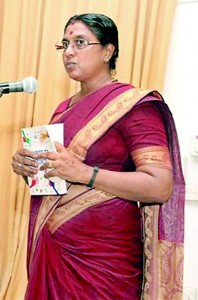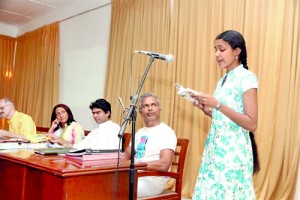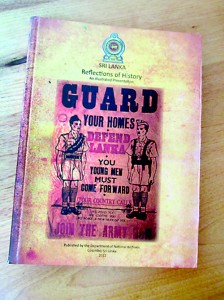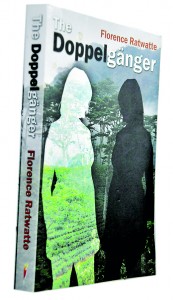Books
View(s):It really worked: Reading to each other “over the fence”
For the first time, after 30 years, southern and northern writers meet in Jaffna to share their work
By Ashok Ferrey
Vivimarie Vanderpoorten, Lal Medawattegedara and I were on the road to Jaffna, courtesy of the Goethe Institut and British Council:

Dr. Amirthanjali Sivapalan
the first time in 30 years that southern and northern writers were meeting there, to read from their work to each other, possibly the first time ever. There were ten northern writers, both young and established. The youngsters had taken part in Shyam Selvadurai’s successful Write to Reconcile project the year before, and were keen to strut their stuff again.
We had two gigs, an afternoon session at Jaffna University arranged by Dr. Amirthanjali Sivapalan of the English Faculty, and a subsequent evening at the St Francis Seminary organised by Father Saveri of the Centre for Performing Arts.
The first thing I noticed was the audience, over 70 the first day, mostly young, all of them enthusiastic. (At any Colombo literary event you’d be hard pushed to have ten Aunties all in a row. Trust me, I’ve been there.) I don’t know, perhaps the charming Amirthanjali had put a gun to their heads and said ‘Be there or else!’ It certainly didn’t feel like that to me. Anyway the response was overwhelming: heartbreaking poems and stories – of war and peace and love and despair, words that had both audience and participants in tears at times. Tomorrow, I thought, there’ll be nobody at the Seminary. (Do priests read? Don’t they have more important things to do like feeding the poor?)
As it happens there were over 60 in that audience – priests, nuns, lay brothers, novices, interested bystanders and us, in a breezy hall overlooking the sea; startling proof that religion is alive and flourishing in Jaffna, in stark contrast to most of the rest of the world. There were many interesting contributions from the novices too.

Voices from the north: Vivimarie Vanderpoorten, Lal Medawattegedera and Ashok Ferrey listen intently to a Jaffna writer’s reading
Then there was a smaller workshop for the English Lit faculty – the students charming and diffident and courteous, the way I imagine people in Colombo must have been, 50 years ago. In between these events there were of course others – morning swims at Casuarina Beach, shopping for curd chillies in the market, and on the last night a truly splendid Jaffna crab dinner thrown by the British Council. (Oh, how hard they made us poor wretches work that weekend!)
One thing seems obvious to me: this sort of exchange has to continue, between other northern writers, other southern writers. After all, we’re not polemicists or politicians; just ordinary people talking to each other over the garden fence. I can think of no better recipe than this for peaceful coexistence.
As for this rather odd business of being a writer – you’d be a fool to imagine you might make money out it. But the really great thing is this: you really do get to enjoy what you do. When I am old and grey and well past it (sometime next week I reckon) I’ll be looking back on this Jaffna trip – and it will be up there in lights, as one of the absolute high points of my career.
Kala Korner by Dee Cee
Reflections of History: Some rare material
During a recent visit to the National Archives I spotted a rather unusual publication. Glancing through its pages I noticed the plethora of illustrations relating to the history of the country. Tilted ‘Sri Lanka – Reflections of History’, the Department of National Archives publication is a treasure not only for historians but to anyone who is interested in getting a glimpse of landmark events and happenings in the country over the past few centuries.
In an introductory note, Editor Dr Saroja Wettasinghe, Director of National Archives explains that the illustrations are mostly from archives and historical publications of yore. There are no monarchical archives of the period from 3rd Century BC to 1815 AD. The publication begins with the Portuguese administration in the maritime areas (1520-1658) during the Kotte-Sitawaka-Kandyan periods. It is interesting to note that although the original archives of this era are not available in Sri Lanka, they are available in Archives in Lisbon and Goa. So are the Dutch documents which are in Dutch archives in Batavia (presently Jakarta) and in their National Archives in The Hague. The material relating to these eras have been obtained from them.
While a large amount of documents relating to the early British administration since 1796 is available here, there is more in the Record Office in Madras (Chennai) and Office Records in London relating to the East India Company period (1796-1801) and those relating to the Crown Colony period (1801-1948) at the Public Records Office in Kew, Surrey, England.
The short notes accompanying the illustrations are interesting and informative. The volume begins with the well-known Ptolemy’s map (15th/15th C) drawn by the Egyptian astronomer and geographer whose system assumed that the earth was the fixed centre of the universe, with the sun, moon and stars revolving round it.
The world’s oldest printed book with a reference to Taprobane – as Sri Lanka was then known – is reproduced next. It had been printed in the press of Johann Besicken in Rome on November 7, 1506 in Latin with thick Gothic lettering. It gives an account of the voyage of Dom Francisco de Almeida in 1505 and his visits to the African coast and arrival in South India.
The Portuguese Era begins with a map of Colombo dating back to 1518 – the year in which Captain Lopo Soares de Albageria asked the King for a plot of land “no more in extent that could be measured by stretching the dried hide from the carcass of a cow or bullock” – to erect a factory. The first fort was built that year with cabook stones.
The Portuguese Tombo with names of villages and the Forals – registers which recorded the tax that had to be paid by the villagers to the King of Portugal and several maps are among other material pertaining to that era.
The Dutch Era is covered with a wide range of material from the treaty between King Rajasinghe II (1629-87) and the Dutch to pictures, maps and documents. The first printing press in the Island was established in 1737 in the time of Dutch governor Van Imhoff and a page of the first book printed in Sinhala is included. There is a wealth of information on activities during that era. A set of pictures on elephant kraals is very interesting. Export of elephants was a lucrative source of revenue for the king and the Dutch. The section ends with the last page of the capitulation document when the British took over from the Dutch.
Although we are used to seeing a lot of documents and pictures of the British era and the post-Independence period, some rare material makes the book richer.
There is hardly any publicity about this sort of valuable publications. Their prices are reasonable because the Department is not making this a money-making venture. Creating awareness of what is available will be worthwhile for researchers, historians and those with particular interests like me.
A heady brew of tea, romance and suspense set in colonial Ceylon
Ceylon tea will soon be 150 years old. In nearly one and a half centuries of producing a beverage of iconic quality and calibre, with a fascinating deja vu of British colonial plantation life, it is strange that the romance and adventure of this great enterprise, which in little more than three decades became the island’s main export and income source, did not inspire a good tea novel.
The long wait was worthwhile, I discovered, when a friend brought me a copy of The Doppelganger by Florence Ratwatte, from London, recently.
The story is set in the picturesque high-country tea plantations of British-colonial Ceylon, in a late 1930s – to end 1940s time-warp, when the island was on the threshold of independence from colonial rule.
Beautiful, gifted Rachel Varuni, the illegitimate daughter of a Scottish tea-planter and a Ceylonese village girl, lives alone with her mother on the edge of the misty High Forest tea estate. Rustic, frugal and hard, their life is also simple and mainly happy. When she is ten years old, Rachel’s life changes dramatically, with a bequest in her father’s will, for her education in Ceylon’s most exclusive private boarding school, high in a hill resort in the tea-country.
Rachel’s idyllic early life changes unrecognizably, as the shy village girl turns into a ravishing, gifted doppelganger, driven by a twist of fortune to attain the goals of her European heritage. She is pitched against vicious racist forces, who see in her, an upstart challenge to the status quo of white-dominated plantation life. Was Rachel’s new identity, which she had pursued and perfected with the single-minded focus of being accepted as an equal in British colonial society, merely an elusive dream, her new-found split-personality pulling her into two different worlds, only to be disowned by both as an alien?
Persecuted and threatened, Rachel sees her mixed race as a confusing torment, not as a best-of-both-worlds pedigree, as was sometimes made out. Lost and crushed in a racial no-man’s land, Rachel mutinies against destiny, not heeding the tragic sadness and heart-break of her own beginnings, as she slips helplessly into a forbidden love-affair.
The Doppelganger has the ideal thriller mix of plot, suspense, character-drawing and skilful writing. Florence Ratwatte’s villains are satisfyingly violent but her lovers are tender. She writes with stylish flair and elegance and despite using a convenient coincidence, it is a book you won’t put down easily.
The Doppelganger by Florence Ratwatte is published by Austin Macauley Publishers Ltd., London and is priced at 7.99 pounds sterling (US $ 11.95). It is also available on the Internet on Amazon and Playcom. It should be available on request from leading book-sellers in Sri Lanka.
| Book facts
The Doppelganger by Florence Ratwatte. Reviewed by Kamala Fernando |


